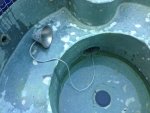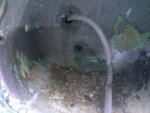Topic says it all. My idea is to get an Intermatic transformer and use the existing wiring to the lams and use the same lamp housings with perhaps a screw adapter for the bulb. Is doing something like this considered safe and legal?
The reason is that a tree root damaged the PVC conduit going to the spa light. After it rains, the GFCI will trip if the spa light is on for more than 5 minutes or so. The GCFI circuit has been replaced but the behavior is the same. There is likely a from water in the ground but barely (since it doesn't trip for after 5 min). My thinking is that reducing the voltage from 120 to 12 will not only drastically reduce the chances of a short (it would not overcome the resistance) but there would be piece of mind with low-voltage current going to the pool instead of 120v should a breaker fail.
The reason is that a tree root damaged the PVC conduit going to the spa light. After it rains, the GFCI will trip if the spa light is on for more than 5 minutes or so. The GCFI circuit has been replaced but the behavior is the same. There is likely a from water in the ground but barely (since it doesn't trip for after 5 min). My thinking is that reducing the voltage from 120 to 12 will not only drastically reduce the chances of a short (it would not overcome the resistance) but there would be piece of mind with low-voltage current going to the pool instead of 120v should a breaker fail.






